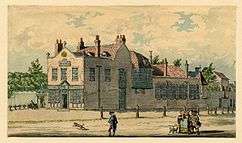John Bevis
John Bevis (10 November 1695 in Old Sarum, Wiltshire – 6 November 1771) was an English doctor, electrical researcher and astronomer. He is best known for discovering the Crab Nebula in 1731.
Bevis has also observed an occultation by Venus of Mercury on 28 May 1737 NS, (17 May 1737 OS) and observed and found a prediction rule for eclipses of Jupiter's moons. From observations made with his telescope at Stoke Newington, Middlesex, he compiled a star catalogue (more of an atlas) entitled Uranographia Britannica around 1750.
In 1757 Bevis published in London a volume on The History and Philosophy of Earthquakes in which he collected accounts of the Lisbon earthquake from diverse authentic sources. His survey, the first of its kind, was subsequently used by John Michell (1761).[1]
In 1757 Bevis was asked by the tobacconist Thomas Hughes to discover why no flowers would grow in his garden at Bagnigge House, which stood in the vicinity of 61-63 King's Cross Road, London. He found the water from the well on the site to be full of iron. On this research, a second well was dug, the water from which was found to be a good purgative. This led to the establishment of one of the most popular 18th Century spas, Bagnigge Wells, the following year.[2]

He was elected a Fellow of the Royal Society in November, 1765.[3] He received his B.A. from Christ Church, Oxford in 1715 and M.A. there also in 1718.[4]
Electrical research
When the Leyden Jar first arrived in the UK (1746), Bevis worked with William Watson in refining it. They removed the water and replaced it with lead shot, then later lined the inside and exterior of the glass with lead. They also experimented to determine the speed of electricity using nearly four kilometers of wire and observing the spark made on entering the wire, and that made on leaving it: they couldn't detect any time delay and concluded it must be almost instantaneous.
Watson and Bevis corresponded extensively with Benjamin Franklin and his group of Philadelphia experimenters and they jointly:
- refined the Leyden jar by coating the inside and outside with tin foil
- joined Leyden Jars together to create a "battery"
- distinguished between the charge in Leyden Jars linked in series from those linked in parallel
- created a flat glass-plate and tin-foil version of the Jar battery (the first flat-plate condensor)
- developed the single-fluid theory of electricity which emphasised a superabundance of the fluid on one side, and a deficit on the other.
- introduced the concept of positive and negative charges.
References
- ↑ Ben-Menahem, Ari (August 1995). "A Concise History of Mainstream Seismology: Origins, Legacy, and Perspectives" (PDF). Bulletin of the Seismological Society of America Vol. 85, No. 4. pp. 1202–1225. Retrieved 21 January 2013.
- ↑ The London Encyclopaedia p.32
- ↑ "Library and Archive catalogue". Royal Society. Retrieved 14 December 2010.
- ↑ Hockey, Thomas (2009). The Biographical Encyclopedia of Astronomers. Springer Publishing. ISBN 978-0-387-31022-0. Retrieved 22 August 2012.
External links
- Short biography at SEDS
- List of fellows of the RAS
- The story of Bagnigge Wells
- Uranographia Britannica, ca. 1745 - Full digital facsimile, Linda Hall Library.
Sources
- Weinreb, B; Hibbert, C, eds. (1983). The London Encyclopaedia. Macmillan London Ltd. ISBN 0-333-45817-6.